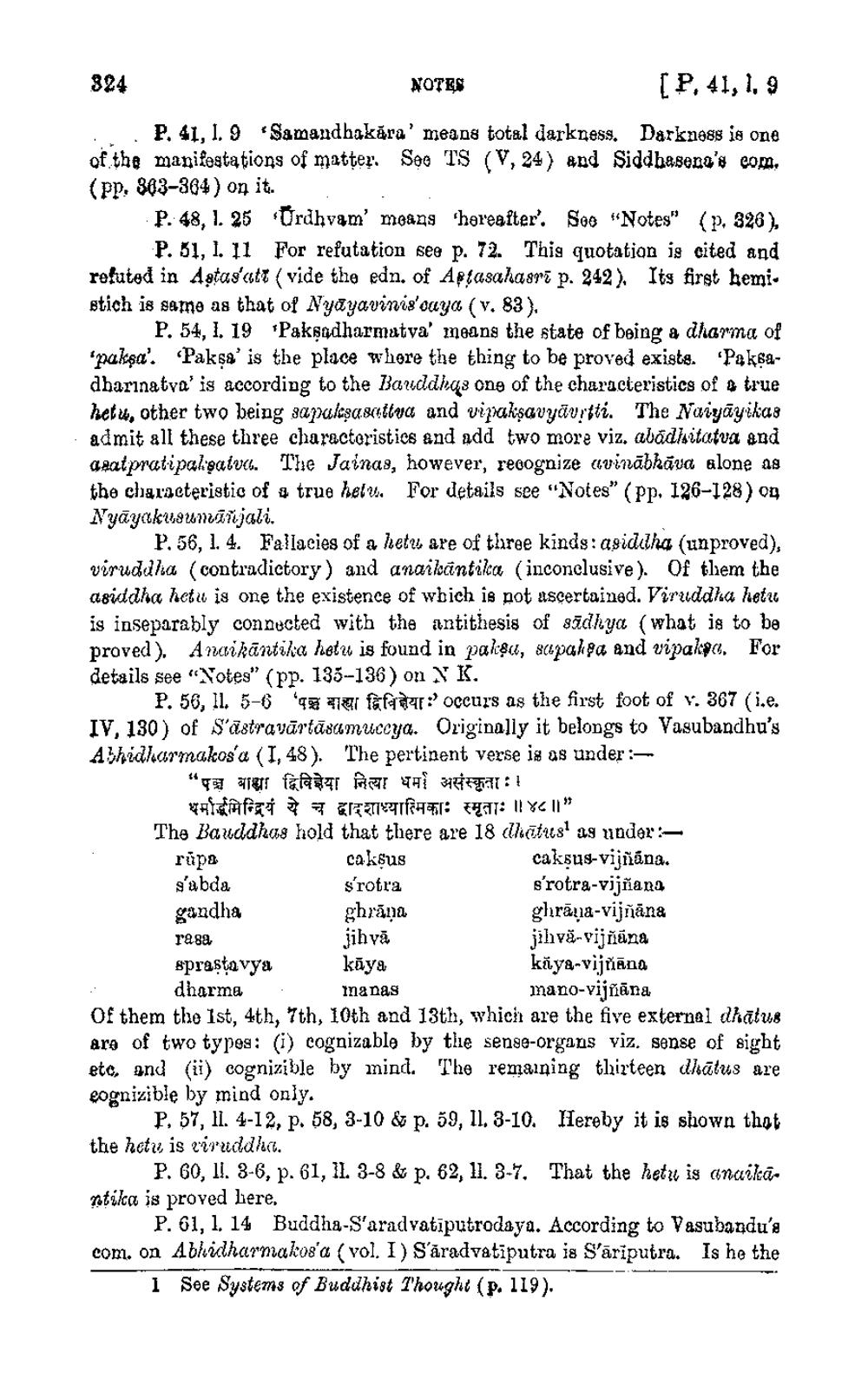________________
[P. 41, 1. 9
P. 41, 1.9 Samandhakara' means total darkness. Darkness is one of the manifestations of matter. See TS (V, 24) and Siddhasena's com. (pp. 363-364) on it.
P. 48, 1. 25
324
Urdhvam' means 'hereafter. See "Notes" (p. 326), P. 51, 1. 11 For refutation see p. 72. This quotation is cited and refuted in Astasatt (vide the edn. of Aștasahasri p. 242). Its first hemistich is same as that of Nyayavinis'saya (v. 83).
P. 54, I. 19 Pakṣadharmatva' means the state of being a dharma of 'paksa'. 'Paksa' is the place where the thing to be proved exists. 'Paksadharinatva' is according to the Bauddhas one of the characteristics of a true hetu, other two being sapakṣasattva and vipakṣavyāvṛtti. The Naiyāyikas admit all these three characteristics and add two more viz, abādhitatva and asatpratipalṣatva. The Jainas, however, recognize avinābhāva alone as the characteristic of a true hetu. For details see "Notes" (pp. 126-128) on Nyāyakusumāñjali.
P. 56, 1. 4. Fallacies of a hetu are of three kinds: asiddha (unproved), viruddha (contradictory) and anaikāntika (inconclusive). Of them the asiddha hetu is one the existence of which is not ascertained. Viruddha hetu is inseparably connected with the antithesis of sadhya (what is to be proved). Anaikantika hetu is found in paksa, sapaksa and vipaksa. For details see "Notes" (pp. 135-136) on N K.
P. 56, 11. 5-6 'qa ar ffar occurs as the first foot of v. 367 (i.e. IV, 130) of S'astravārtāsamuccya. Originally it belongs to Vasubandhu's Abhidharmakosa (I, 48). The pertinent verse is as under:
" पत्र वाचा द्विविज्ञेया नित्या धर्मा असंस्कृता: ।
धर्मार्द्धमिन्द्रियं ये च द्वादशाध्यात्मिकाः स्मृताः ॥ ४८ ॥
The Bauddhas hold that there are 18 dhatus1 as under:
rūpa
s'abda
gandha
rasa
NOTES
sprastavya dharma
caksus
s'rotra
ghrapa
jihva
kāya
inanas
cakṣus-vijñāna.
s'rotra-vijñana
ghrana-vijñāna
jihvä-vijñāna
kaya-vijñāna mano-vijñāna
Of them the 1st, 4th, 7th, 10th and 13th, which are the five external dhātus are of two types: (i) cognizable by the sense-organs viz. sense of sight etc, and (ii) cognizible by mind. The remaining thirteen dhātus are cognizible by mind only.
P. 57, II. 4-12, p. 58, 3-10 & p. 59, Il. 3-10. Hereby it is shown that the hetu is viruddha.
P. 60, 11. 3-6, p. 61, II. 3-8 & p. 62, 11. 3-7. That the hetu is anaikā. ntika is proved here.
P. 61, 1. 14 Buddha-S'aradvatiputrodaya. According to Vasubandu's com. on Abhidharmakos'a (vol. I) S'aradvatiputra is S'ariputra. Is he the
I See Systems of Buddhist Thought (p. 119).




